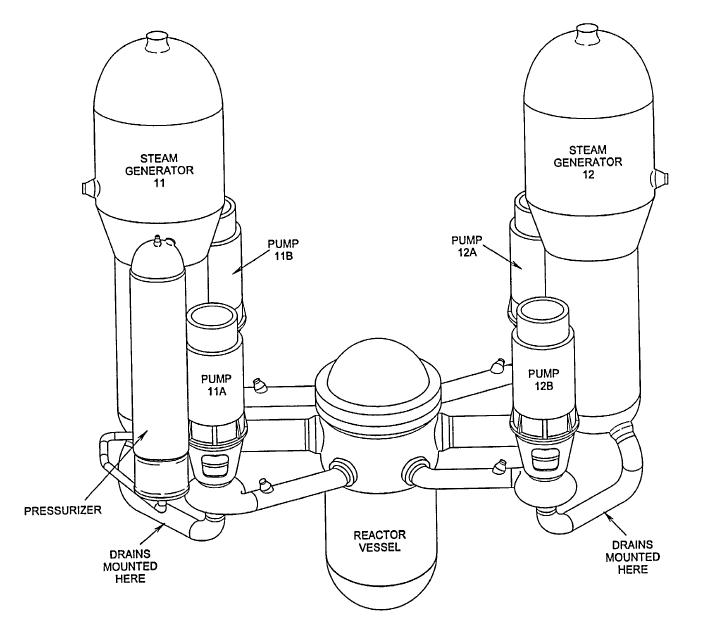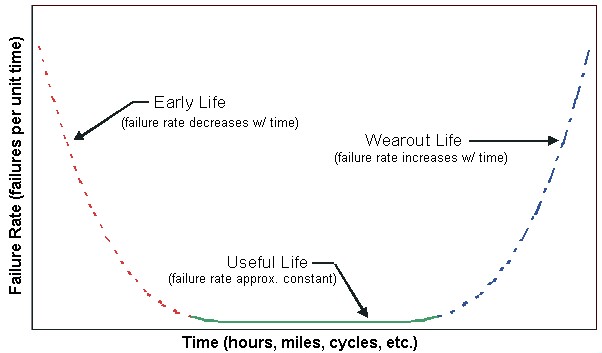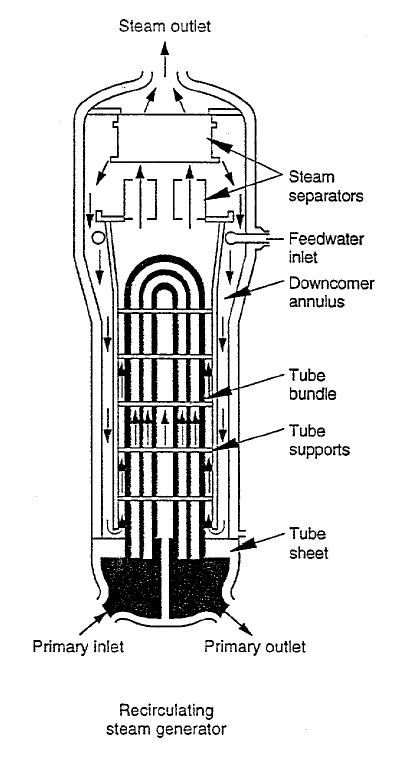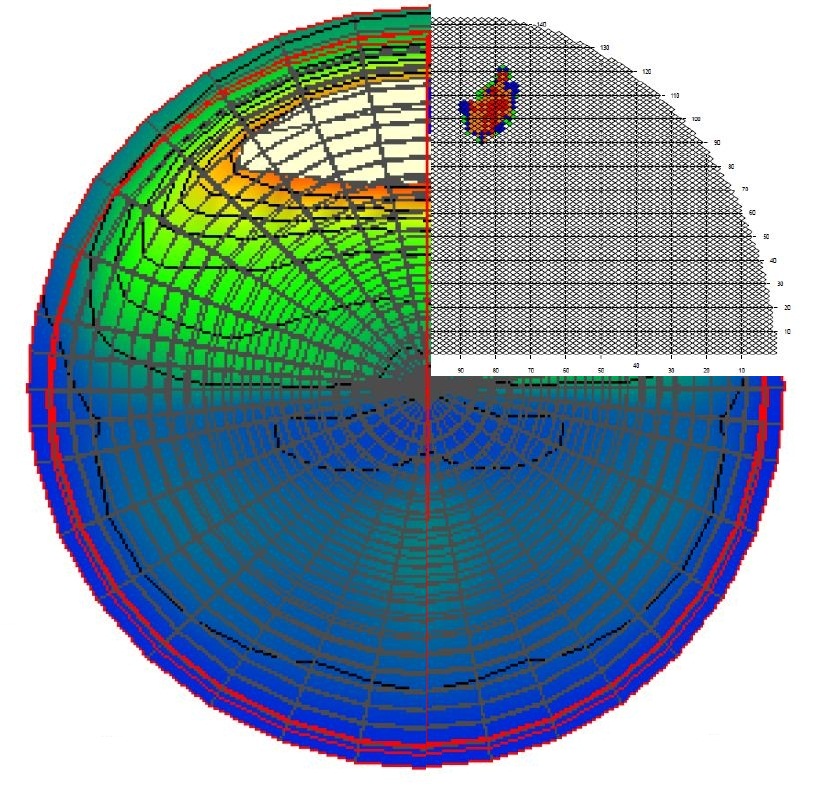In March, I posted a blog about the steam generator tubes at San Onofre. Here is some additional information about the situation there.
On January 31, 2012, operators received indications that a small amount of reactor coolant water was leaking through one or more of the thousands of tubes inside the two steam generators for the Unit 3 reactor at the San Onofre Generator Station (SONGS) in California.
The primary system for each of the two operating reactors at San Onofre consists of a reactor vessel housing the reactor core, two steam generators, four reactor coolant pumps, one pressurizer, and associated piping and valves. Water heated while flowing past the reactor core is pumped through thousands of tubes inside the steam generators. Heat is conducted through the thin metal walls of the tubes to boil water surrounding the tubes within the steam generator. The cooled water is pumped back to the reactor vessel to be reheated. Pipes carry steam from the steam generators to the turbine where it is used to make electricity.
As the cooling water flows through the reactor core, the radiation creates an isotope of nitrogen (N-16) in the water. This nitrogen isotope has a short half-life of slightly over 7 seconds and emits a beta particle. Radiation detectors installed near the pipes transporting steam from the steam generators to the turbine monitor for beta particles. Because this steam will be non-radioactive unless reactor coolant water is leaking through steam generator tubes, the radiation detectors provide reliable indications of steam generator tube integrity, or lack thereof. Procedures require the operators to manually shut down the reactor if they detect leakage from the tubes.
Workers found leaks in the steam generator tubes in Unit 2 and replaced the steam generators during a refueling outage between September 2009 and April 2010. Unit 2 was shut down for another refueling outage when Unit 3 experienced its tube leak in January 2012. Workers replaced the steam generators on Unit 3 during a refueling outage between October 2010 and February 2011. Operators restarted Unit 3 on February 18, 2011, and it ran less than a year before experiencing the tube leak. The original steam generators had been in service for nearly 30 years since the reactors began operating in the early 1980s.
A failure trend commonly called the “bathtub curve” (Figure 2) due to its shape explains what happened to San Onofre’s steam generators. The curve shows the chance of failure over a product’s lifetime. The failure rate is lowest in the middle. The failure rate increases on the right-hand side of the curve. This is called the “wear-out” phase as aging mechanisms like rusting and embrittlement increase the likelihood of failure. With the original steam generators at San Onofre approaching, if not already in, this wear-out phase, its owners elected to replace the steam generators on both operating reactors.
But the replacement steam generators began service not in the middle part of the bathtub curve where failure rates are lowest, but on the left-hand portion of the curve. This is called the “break-in” phase where failure rates are initially high due to material defects, assembly mistakes, design errors, and related problems.
The company sought to upgrade performance with the replacement steam generators. The original steam generators had tubes made from a type of steel called Alloy 600. This metal had very good heat transfer properties. But Alloy 600 was vulnerable to stress corrosion cracking, a degradation mechanism that caused tubes to be removed from service by plugging them when more than 40% of their thin walls are cracked or worn. The replacement steam generators featured tubes made from Alloy 690 which had been shown to be significantly more resistant to stress corrosion cracking.
While the replacement steam generators were equipped with better materials, they had different designs. Each of the original steam generators had 9,350 tubes approximately ¾-inches in diameter with walls about 0.043 inches thick. Each replacement steam generator had 9,727 tubes approximately ¾-inches in diameter with walls about 0.048 inches thick.
Inspections within the Unit 2 and 3 replacement steam generators identified more than 7½ percent of the tubes in each having detectable indications of wear.
|
Replacement Steam Generator Tubes with Wear Indications |
||||
|
Wear <20% |
Wear >20% |
Total |
Percent |
|
|
Unit 2-88 |
1,006 |
78 |
734 |
7.5 |
|
Unit 2-89 |
1,264 |
69 |
861 |
8.9 |
|
Unit 3-88 |
1,371 |
390 |
919 |
9.4 |
|
Unit 3-89 |
1,288 |
363 |
887 |
9.1 |
| Table 1: Columns 2 and 3 are the number of wear spots found, which includes multiple wear spots on individual tubes. Here “20%” refers to wear that has eroded 20% of the original thickness of the tube. “Total” gives the number of tubes that show at least one detectable wear spot. “Percent” refers to the percentage of the 9,350 tubes in each steam generator having detectable signs of wear. | ||||
Most of the tube damage within the Unit 3 replacement steam generators has been attributed to tube-to-tube wear. Hot water flowing inside the tubes and steam flowing outside them caused tubes to vibrate back and forth, bumping into adjacent tubes. These were not violent collisions like when the Titanic rammed an iceberg but small rubs – lots of small rubs literally thousands upon thousands of times.
The flow patterns inside the tubes had been extensively analyzed using computer programs modeling the temperature, pressure, and flow conditions. In hindsight, it appears those computer simulations were not realistic.
In a steam generator, hot water from the reactor vessel enters the tubes via the primary inlet and exits through the primary outlet shown in the figure. Water is supplied to the steam generator through the feedwater inlet. Baffles force this feedwater flow to first encounter the tubes at their lower regions. The feedwater is warmed to the boiling point as it flows upward along the length of the vertical tubes.
The computer models consider the geometry of the steam generators and the properties (e.g., temperature, pressure, and velocity) of the fluid inside and outside the tubes to calculate things like where along the length of the tubes the feedwater flow reaches the boiling point to form steam bubbles.
The tube-to-tube wear considered to have caused the extensive damage inside the Unit 3 replacement steam generators has been blamed on a phenomenon termed “fluid-elastic instability.” This theory basically has steam bubbles forming earlier – and thus at lower levels within the steam generator – than predicted in the computer simulations. Steam bubbles, less dense than water, applied more force to the tubes particularly to the sides of the tubes in the U-shaped bend region.
The figure looks down at a cross-section of the steam generator and shows the location in the upper right quadrant where the worst tube-to-tube damage was found superimposed on the NRC’s computer calculation of maximum steam flow velocities. The bottom half shows relatively low velocities because these tubes are carrying the cooler water flowing down towards the primary outlet. The upper half has the tubes filled with hotter water flowing upward toward the U-bend area. This region within the steam generator produces more steam with higher velocities. The steam velocities towards the periphery of this side are higher than the velocities in its center because the tubes in the center bend first and are therefore shorter than the tubes near the outside. The outer tubes have a longer heating length over which to produce steam.
Because the computer models failed to accurately predict steam flow conditions inside the replacement steam generators, they failed to accurately determine the forces causing tubes to vibrate and rub against each other. The role and placement of anti-vibration bars and retainers within the steam generator to handle the forces and dampen any resulting vibrations was consequently misunderstood.
San Onofre’s owner proposes to restart the Unit 2 reactor after plugging tubes potentially susceptible to the tube-to-tube wear experienced on Unit 3. But only two tubes among 19,454 tubes in the replacement steam generators for Unit 2 had indications of such wear. Unit 2 had operated considerably longer than Unit 3 with replacement steam generators made by the same vendor from identical materials to the same design. For not well understood reasons, Unit 3’s tubes experienced more extension damage.
To provide additional margin against the Unit 3 degradation mechanism, San Onofre’s owner proposes to operate Unit 2 at no more than 70 percent power for no longer than 150 days before shutting down to check again on what’s going on inside the steam generators.
Plugging hundreds of tubes as a precautionary measure may have unintended consequences. The pumps moving water from the reactor vessel to the steam generators have one speed. Thus, roughly the same amount of water will enter each steam generator. But that water will have fewer places to go inside the steam generators because of all the plugged tubes. Water will flow through the surviving tubes at higher velocities. Where steam bubbles form outside the tubes also changes, as plugged tubes no longer provide heating while higher velocities in the remaining tubes may cause warmer water over longer lengths of those tubes.
Our Takeaway
The plant’s owner and the NRC contend that most of the damage to the Unit 3 replacement steam generators was caused by tube-to-tube wear. Because the computer simulations of flow conditions within the steam generators were not accurate, forces that reportedly caused the tubes to vibrate against each other were missed.
Now these same computer codes have been applied to the replacement steam generators but with hundreds of tubes plugged. Perhaps via a road trip to the nearby Enchanted Kingdom, the formerly clueless codes have magically been transformed into clueful codes that show tube degradation will not occur. Or at least, not be damaged again.
Back in school, we called this process either a nuclear experiment or a lab test. At San Onofre, it’s called generating revenue.
The nuclear industry and the NRC claim to place safety ahead of production.
Alphabetically, production is ahead of safety.
If Unit 2 at San Onofre restarts based on a guess instead of a solid, bulletproof understanding of what’s causing so many steam generator tubes to wear so rapidly, production will be ahead of safety not just in dictionaries but also in people’s back yards.
In dictionaries, responsible comes between production and safety. Time will tell where NRC fits responsible in.
“Fission Stories” is a weekly feature by Dave Lochbaum. For more information on nuclear power safety, see the nuclear safety section of UCS’s website and our interactive map, the Nuclear Power Information Tracker.




